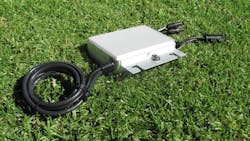On Aug. 7, I was proud to join with other Western Electric Industry Leaders Group members representing energy companies throughout the Western United States in calling for the installation of “smart inverters” on all new solar generators in the region. These simple and inexpensive devices provide the necessary voltage support for us to integrate intermittent renewable resources effectively and prevent costly future renovations and reliability impacts. This vital initiative will actually encourage the installation of more renewable energy, enabling its continued growth in a reliable manner for the benefit of the region.
The main challenge with renewable resources such as wind and solar is that they tend to be intermittent by nature. If a cloud covers the sun, or the wind stops blowing, the power output of these sources can become unavailable suddenly and indefinitely. The key, then, is to integrate them onto the grid without sacrificing reliability during these unpredictable fluctuations. That is where the smart inverters will play a vital, transformative role. These devices can mitigate both excessive voltage and voltage drops caused by fluctuating solar generation, thus preventing potential power quality problems. However, if smart inverters are not installed, these voltage swings can potentially damage utility equipment and residents’ home appliances; increase overall cost of maintaining the grid; require continued installation of larger, more expensive alternatives; and could even contribute to distributed outages.
This problem is a major concern not only for U.S. utilities and regulators, but has already caused the government of Germany, where renewable installations are particularly common, to order a mass retrofit of smart inverters on solar installations at a cost of hundreds of millions of dollars. Our Western utilities have the opportunity to avoid this scenario by planning ahead and installing the smart inverters before reliability is affected on our system. This will allow the smooth integration of these environmentally friendly resources while ensuring the integrity and reliability of our overall system. With tens of thousands of solar arrays already installed in the region, WEIL Group member companies have studied this issue extensively and found significant improvement in power quality when smart inverters are placed on the system.
This change is well worth the small cost to the consumers who choose to use solar installations. For a solar installation costing $12,000[1], these new smart inverters will only cost about $150 more than the current inverters, approximately 1 percent of the overall cost. This is a bargain price given the expensive retrofit process in Germany. In the future, the cost should be even lower as smart inverter functions become standard features. Furthermore, many of the larger solar installations have inverters with “smart” capabilities, which just need to be turned on to operate.
Smart inverters are imperative to integrating large amounts of renewable energy and realizing the many environmental benefits of these resources, while maintaining the vital integrity and reliability of the system that millions of people rely on every day. We have the opportunity to successfully address this challenge together. We are urging all of our State public service commissions and/or legislatures to act decisively on these issues to overcome any potential threats to our grid, and hence to our millions of customers. In parallel, the industry will continue to work with the applicable standards organizations, such as Underwriters Laboratories (UL) and the Institute of Electrical and Electronics Engineers (IEEE), to ensure smart inverters meet electrical safety and industry standards.
By encouraging the widespread adoption of smart inverters that promote renewable integration, America will have a safer, more efficient and greener energy system for everyone. This effort will allow customers, technology, and renewable energy sources to come seamlessly together to create an even better, cleaner grid for our nation.
[1] The $12,000 cost is based on a 3 kW rooftop PV system costing $4/watt including installation.

